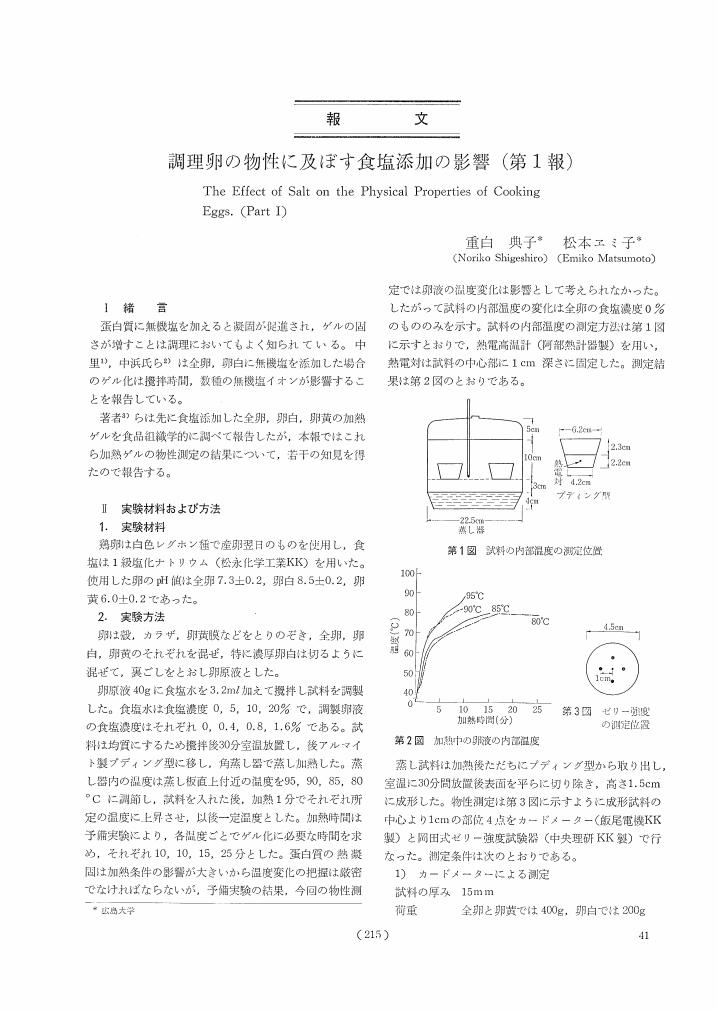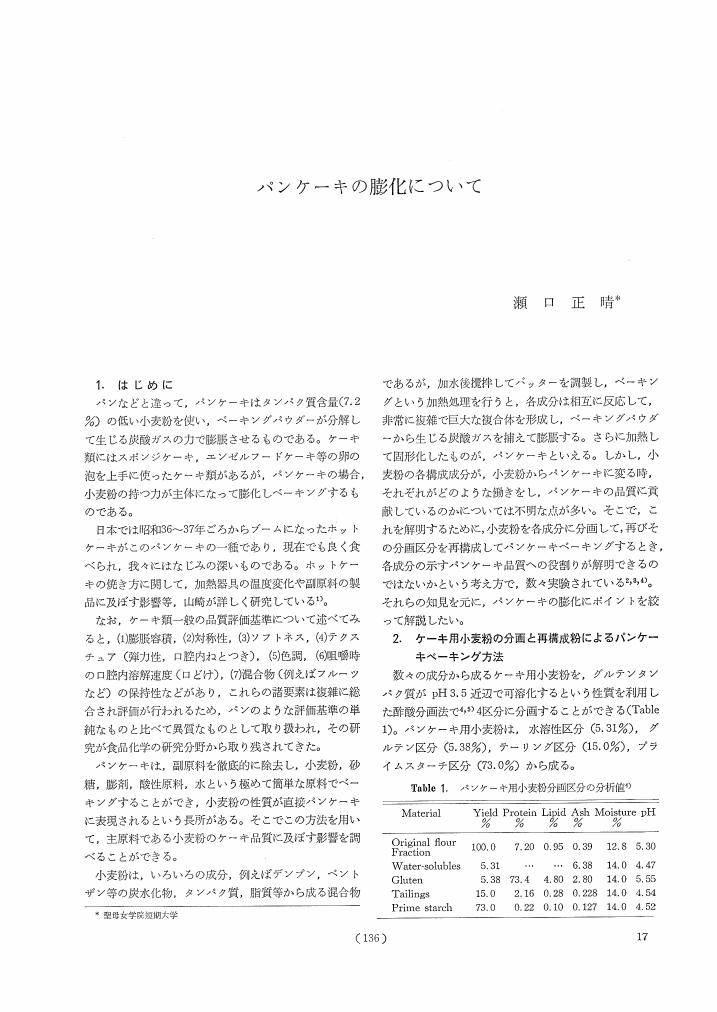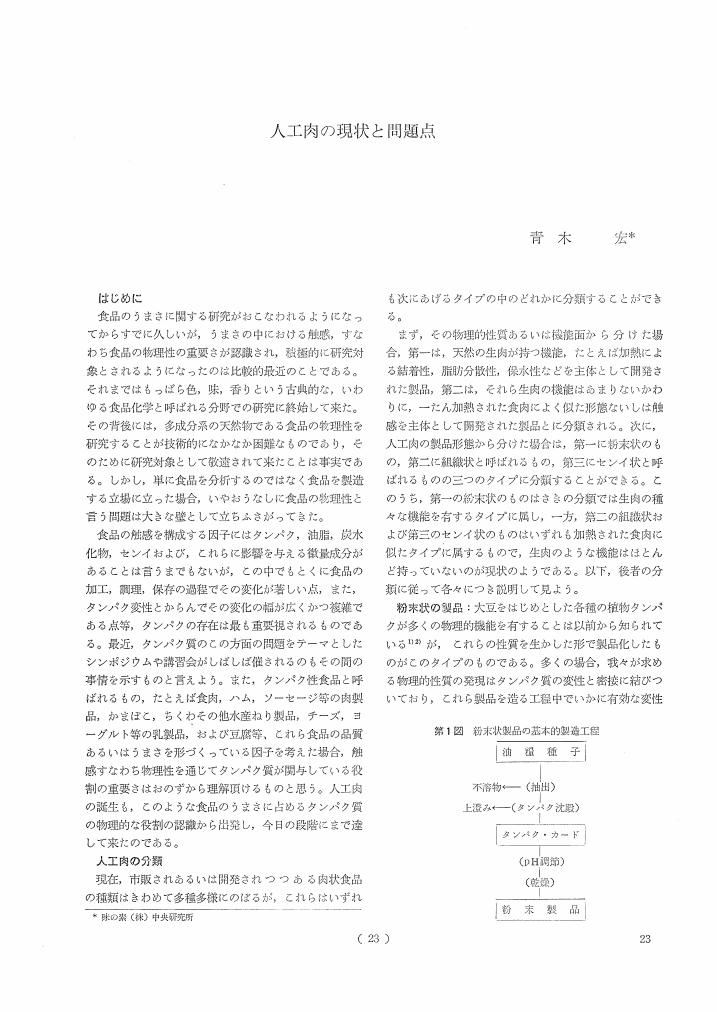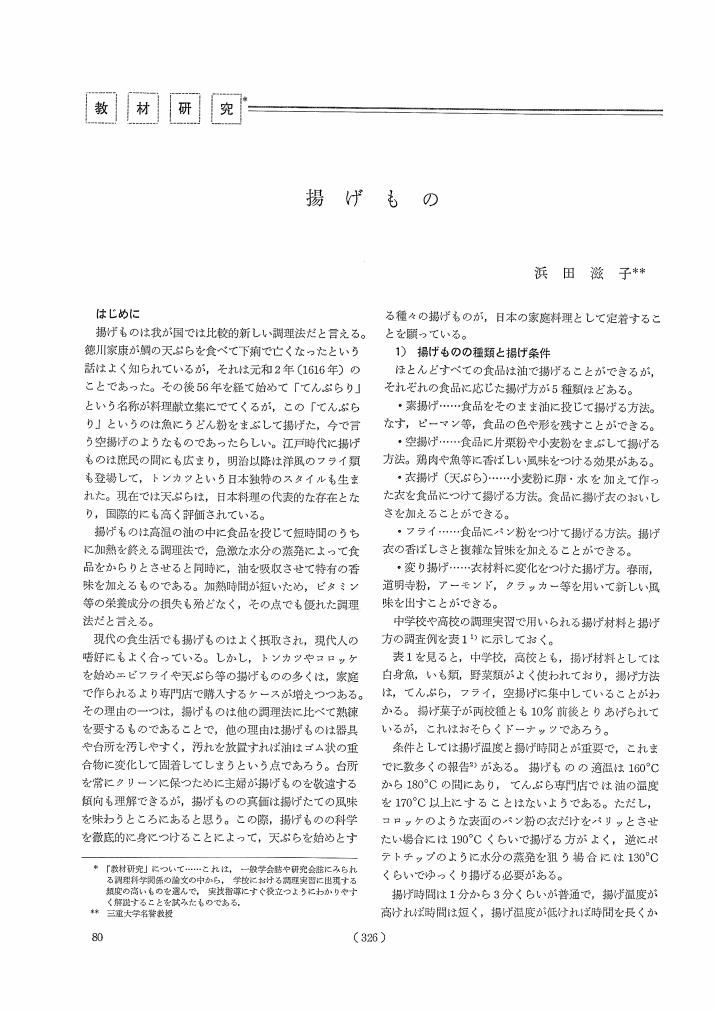1 0 0 0 OA 食品の乾燥(2)
- 著者
- 林 弘通
- 出版者
- 一般社団法人 日本調理科学会
- 雑誌
- 調理科学 (ISSN:09105360)
- 巻号頁・発行日
- vol.25, no.1, pp.66-75, 1992-02-20 (Released:2013-04-26)
- 参考文献数
- 4
1 0 0 0 OA 伝統的な台所用具の知恵
1 0 0 0 わが国における食事用の二本箸の起源と割箸について
1 0 0 0 OA マカダミア・ナッツ(Macadamia ternifolia)のタンパク質について
- 著者
- 光永 俊郎 安達 潤子 蔵前 栄子 荒堀 圭子
- 出版者
- 一般社団法人 日本調理科学会
- 雑誌
- 調理科学 (ISSN:09105360)
- 巻号頁・発行日
- vol.15, no.4, pp.217-221, 1982-12-20 (Released:2013-04-26)
- 参考文献数
- 15
- 被引用文献数
- 1
1)マカダミアナッツの可溶性タンパク質を,水,食塩水,アルコール溶液,水酸化ナトリウム溶液を用いて分別抽出した.抽出率は97%であり,主画分は,アルブミンで,総タンパク質の約70%を占めていた.次いで,グルテリン,グロブリン,プロラミンの順であった.2)各タンパク質画分の電気泳動像は,それぞれ特徴のあるパターンを示し,各画分とも多種類のポリペプチドよりなり,プロラミン,グルテリン画分は,高分子ポリペプチドを多く含んでいた.3)各画分のアミノ酸組成は,グルタミン酸,アルギニンの高含量,含硫アミノ酸の低含量を特徴とし,アミノ酸価は,17.1から51.4であった.全タンパク質は51.4でごまのタンパク質とほぼ同じ値を示した.4)アルブミン画分は,ゲル濾過により,6画分にわけられた.さらにこれらの画分の電気泳動像は,それぞれ3~10種のパンドが認められ,極めて多種類の構成ポリペブチドよりなることを示した.
1 0 0 0 OA 調理卵の物性に及ぼす食塩添加の影響 (第1報)
- 著者
- 重白 典子 松本 ヱミ子
- 出版者
- 一般社団法人 日本調理科学会
- 雑誌
- 調理科学 (ISSN:09105360)
- 巻号頁・発行日
- vol.9, no.4, pp.215-218, 1976-12-20 (Released:2013-04-26)
- 参考文献数
- 10
- 被引用文献数
- 2
1 0 0 0 OA カレー粉加熱香気成分の同定と調理による変化
- 著者
- 河村 フジ子 加藤 和子 畑中 としみ
- 出版者
- 一般社団法人 日本調理科学会
- 雑誌
- 調理科学 (ISSN:09105360)
- 巻号頁・発行日
- vol.20, no.3, pp.240-245, 1987-11-20 (Released:2013-04-26)
- 参考文献数
- 14
- 被引用文献数
- 1
The aroma components in cooked curry powder were determined and the differences of the aroma due to varieties of curry powder, cooking process and cooking periods were studied. The results were as follows;1) Seventeen aroma components were determined from cooked curry powder.2) The aroma components in the two kinds of current curry powders were almost the same qualitatively but different quantitatively.3) The yield of some components in Turmeric, Cuminaldehyde, and Eugenol was markedly decreased by cooking with margarin.4) The yield of all other components in Turmeric was markedly decreased by cooking after sauted with margarin.5) The amounts of aromas in curry powder, curry powder with margarin, and curry powder sauted with margarin at 100°C were markedly decreased by 30 minutes cooking. On the other hand the amounts of aromas in sauted with margarin at 140°C after 60 minutes cooking were larger than those of 30 minutes cooking.6) Some components in Turmeric and Eugenol were not easily volatile for prolonged cooking.7) Sensory evaluation suggested that the aroma components in curry powder were volatilized by adding margarin and more by sauted with margarin. The curry powder sauted with margarin at 140°C was unpreferred. The aroma in non-cooked curry powder added to hot water was stronger than that in cooked one for one hour, however, there was no significant difference in aroma quality between the two after 1 to 3 hours cooking. There was no significant difference among preferrence by several cooking periods.
1 0 0 0 OA マーマレード作製中のナリンギン量の変化について
- 著者
- 諸星 俊雄 菅原 龍幸
- 出版者
- 一般社団法人 日本調理科学会
- 雑誌
- 調理科学 (ISSN:09105360)
- 巻号頁・発行日
- vol.4, no.2, pp.116-118, 1971-06-20 (Released:2013-04-26)
- 参考文献数
- 6
- 被引用文献数
- 2
1 0 0 0 OA パンケーキの膨化について
- 著者
- 瀬口 正晴
- 出版者
- 一般社団法人 日本調理科学会
- 雑誌
- 調理科学 (ISSN:09105360)
- 巻号頁・発行日
- vol.17, no.3, pp.136-142, 1984-09-01 (Released:2013-04-26)
- 参考文献数
- 17
- 被引用文献数
- 2
1 0 0 0 奈良時代の栄養状態:写経生と班田農民を中心として
- 著者
- 瀬尾 好子 従野 敦子 大 塚滋
- 出版者
- 一般社団法人 日本調理科学会
- 雑誌
- 調理科学 (ISSN:09105360)
- 巻号頁・発行日
- vol.15, no.1, pp.51-56, 1982
For estimating nutritive conditions of ancient Japanese, the supplies of foods to the employees of Bureau of Sutra Transcript of Todaiji in 762, which appeared in the Archives of Shosoin, were analyzed, together with provisions of ordinary farmers working in kubunden.<BR>Supplied goods for the workers in the Bureau differed according to their ranks (Table 1). Polished rice given to kyoji (senior sutra transcribers) was as much as 1.2kg, whereas only 960g was given to kosei (correctors) and 720g to zatsushi (miscellaneous servers). Unpolished rice (1.2kg) was given to kushi (underservants).<BR>Though they were given a variety of foods, the energy mainly depended on rice (Table 3). While kyoji, kosei and kushi were supplied with large excess of energy per capita per day, the amount of rice furnished to zatsushi (720g,2426kcal) is considered to be feasonable. It is considered that the foodstuffs actually fed at the Bureau were the level somewhere about that for zatsushi and the rest were given in the form of materials as salaries. The amounts of supplied foodstuffs in Table 1 were corrected so that the rice supplies are to match that to zatsushi as the standard (Table 4). The level of nutrients thus corrected is listed in Table 5.<BR>As a result, the intake of phosphorus (mainly from rice) and sodium (from seaweeds and hishiho) were too high, but those of lipids and vitamin A. Bs and C were slightly low as compared with the present standard dietary allowances.<BR>The majority of the nation were farmers who worked in kubunden and could maintain selfsupports from the part of the harvest. However, it is considered that the rice supplies were only to fulfil 60 to 80% of their necessary energy which was obtainable from 720g of rice. They had to make up the nutritional shortage by eating mixed crops and weeds.
1 0 0 0 OA 宍道湖七珍
- 著者
- 長沢 嘉子 小松原 紀子
- 出版者
- 一般社団法人 日本調理科学会
- 雑誌
- 調理科学 (ISSN:09105360)
- 巻号頁・発行日
- vol.19, no.1, pp.41-44, 1986-02-20 (Released:2013-04-26)
- 参考文献数
- 1
1 0 0 0 OA 揚げ衣の品質に及ぼすゴマ油の混合効果
- 著者
- 川染 節江 山野 善正
- 出版者
- 一般社団法人 日本調理科学会
- 雑誌
- 調理科学 (ISSN:09105360)
- 巻号頁・発行日
- vol.25, no.3, pp.201-206, 1992-08-20 (Released:2013-04-26)
- 参考文献数
- 11
- 被引用文献数
- 1
The quality of fried batter of Tempura (Koromo) was studied by sensory evaluation and moisture measurement using eight different oils (safflower, grapeseed, sunflower, cottonseed, corn, soybean, sesame and rapeseed oils) and then the effect of sesame oil added to soybean oil was investigated. Batters were prepared with 50g of distilled water and 25g of flour and fried into flakes in 400g oil at 175°C.The three samples fried in safflower, grapeseed and sunflower oils were judged organoleptically to be worse than those fried in the other five oils. The sample fried in sesame oil was evaluated to have the best flavor. It was found by multiple regression analysis that the taste and mouthf eel of the samples fried in the four oils, safflower, grapeseed, sunflower and cottonseed oils contributed more strongly to the total acceptance than the flavor. All the flavor, taste and mouthfeel of the sample fried in sesame oil was found also to contribute to the total acceptance.Two mixtures of 30 and 50% sesame oil and soybean oil contributed more strongly than a mixture of 0,10, and 100% to the quality of the fried batter. lt was found by multiple regression analysis that the taste of the sample fried in 30% of sesame oil mixture contributed to the total acceptance, and all the flavor, taste and mouthf eel of the samples fried in 50 and 100% sesame oil mixture contributed to the total acceptance. Negative higher correlation was obtained between the moisture content and the value of mouthfeel than between the moisture content and the flavor, and also between the moisture content and taste.From these results, we conclude that addition of sesame oil of 30-50% in sesame oil/soybean oil mixture improves the quality of fried batter of Tempura (Koromo).
1 0 0 0 OA 天ぷら油の使用に関する問題点
- 著者
- 浦上 智子
- 出版者
- 一般社団法人 日本調理科学会
- 雑誌
- 調理科学 (ISSN:09105360)
- 巻号頁・発行日
- vol.7, no.4, pp.176-181, 1974-12-20 (Released:2013-04-26)
- 参考文献数
- 35
1 0 0 0 OA 最近における乳の殺菌・滅菌について
- 著者
- 菊池 榮一
- 出版者
- 一般社団法人 日本調理科学会
- 雑誌
- 調理科学 (ISSN:09105360)
- 巻号頁・発行日
- vol.19, no.2, pp.78-85, 1986-07-20 (Released:2013-04-26)
- 参考文献数
- 30
1 0 0 0 OA 人工肉の現状と問題点
- 著者
- 青木 宏
- 出版者
- 一般社団法人 日本調理科学会
- 雑誌
- 調理科学 (ISSN:09105360)
- 巻号頁・発行日
- vol.3, no.1, pp.23-30, 1970-02-20 (Released:2013-04-26)
- 参考文献数
- 17
- 被引用文献数
- 1
1 0 0 0 OA ニトロソアミンと調理
- 著者
- 谷村 顕雄
- 出版者
- 一般社団法人 日本調理科学会
- 雑誌
- 調理科学 (ISSN:09105360)
- 巻号頁・発行日
- vol.5, no.1, pp.19-25, 1972-02-20 (Released:2013-04-26)
- 被引用文献数
- 2
1 0 0 0 OA 揚げもの
- 著者
- 浜田 滋子
- 出版者
- 一般社団法人 日本調理科学会
- 雑誌
- 調理科学 (ISSN:09105360)
- 巻号頁・発行日
- vol.27, no.4, pp.326-331, 1994-11-20 (Released:2013-04-26)
- 参考文献数
- 12
1 0 0 0 OA 泡立ち油の再生法の検討
- 著者
- 太田 静行 奥平 巌
- 出版者
- 一般社団法人 日本調理科学会
- 雑誌
- 調理科学 (ISSN:09105360)
- 巻号頁・発行日
- vol.1, no.2, pp.94-96, 1968-07-25 (Released:2013-04-26)
- 参考文献数
- 11
- 被引用文献数
- 1
1 0 0 0 月餅の皮に関する研究 : 主として糖水について
月餅の皮は日数を経過しても軟らかさを保っている、この理由を明らかにし、また材料の1つであるかん水の役割について検討した。(1)従来法により調製した月餅皮のドウ及び焼成した皮について検討した結果月餅のドウは食酢の添加の有無及び糖水の保存期間の長短にかかわらず物性の変化は殆どみられなかった。しかし焼成した皮では食酢を添加した糖水、あるいは長期間保存した糖水を用いた場合には軟らかい皮が得られた。また焼成1週間後のものは焼成直後のものより軟らかいものが得られた。(2)酸を添加した糖水の成分の変化をグラニュー糖を用いて調べた。その結果加熱過程中に転化糖が生成されることが明らかになり、またこれを保存することにより転化の進行が認められ、保存温度20℃より37℃の方が転化度は高かった。酸の無添加の糖水ではほとんど転化は見られなかった。(3)転化糖の存在が皮を軟らかくするように思われたのでモデル実験を行った。すなわち転化糖の量を三段階に変化させた糖水を用いて月餅皮を焼成した結果、転化糖量の多いものほど、しっとりとした軟らかい皮が得られ、転化糖が皮の物性に寄与していることが判明した。(4)かん水の使用が月餅皮の色に及ぼす影響について、かん水を用いないものを対照として比較したところ焼き色に好ましい色を与えることが明らかになった。
1 0 0 0 OA タピオカ澱粉スポンジケーキの膨賑と収縮に関する研究
スポンジケーキを鶏卵、砂糖、タピオカ澱粉の各々同重量で調製し、小麦粉または小麦澱粉で調製したスポンジケーキと比較した。タピオカ澱粉スポンジケーキの特徴は、中央部が大きく落ち窪んだ形状である。これはタピオカ澱粉バッターがオーブンの中で大きく膨張した後収縮し、更に放冷中にも大きく収縮したためである。タピオカ澱粉バッター中の澱粉粒子の沈降試験の結果とバッターの減圧膨脹試験の結果、上記の現象はその大きな沈降速度によってもたらされるバッターの中のタピオカ澱粉粒子の不均一な分散が要因となっていると考えられた。また、アミログラフの結果によると、タピオカ澱粉粒子の糊化特性は、低温でも糊化しやすく、粘度が高く、ブレイクダウンが大きいという特徴をもっていた。そのため、タピオカ澱粉ケーキの気孔壁が粘質となり、固定化がしっかり行われず、これがケーキ収縮の要因になったと考えられる。










